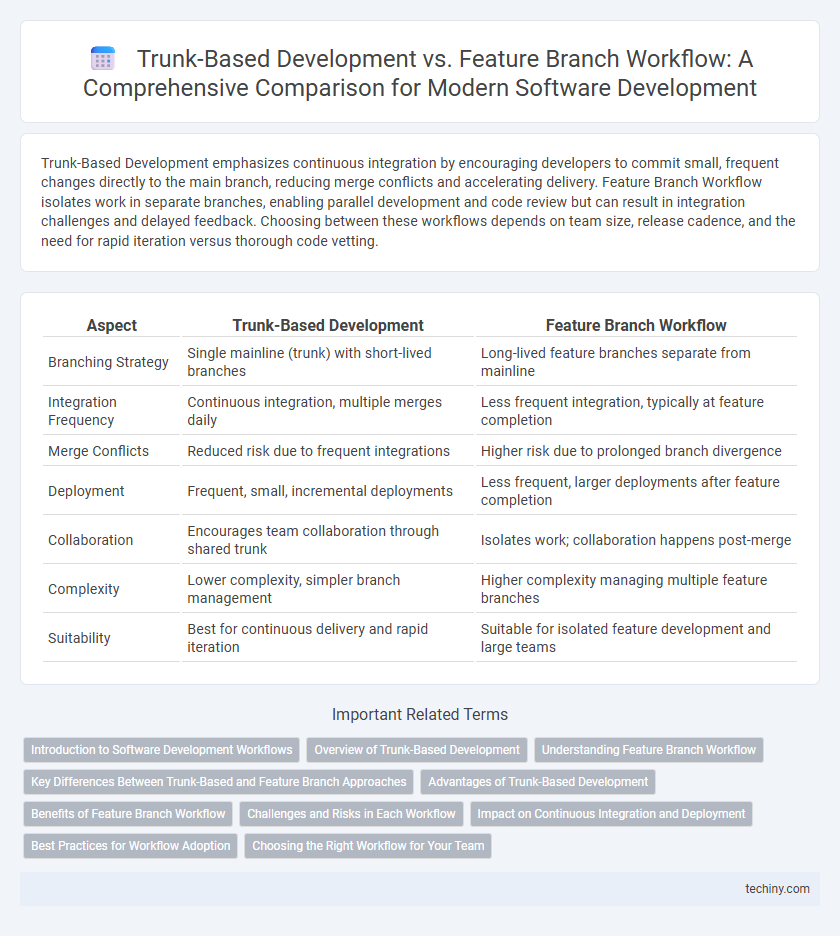Trunk-Based Development emphasizes continuous integration by encouraging developers to commit small, frequent changes directly to the main branch, reducing merge conflicts and accelerating delivery. Feature Branch Workflow isolates work in separate branches, enabling parallel development and code review but can result in integration challenges and delayed feedback. Choosing between these workflows depends on team size, release cadence, and the need for rapid iteration versus thorough code vetting.
Table of Comparison
| Aspect | Trunk-Based Development | Feature Branch Workflow |
|---|---|---|
| Branching Strategy | Single mainline (trunk) with short-lived branches | Long-lived feature branches separate from mainline |
| Integration Frequency | Continuous integration, multiple merges daily | Less frequent integration, typically at feature completion |
| Merge Conflicts | Reduced risk due to frequent integrations | Higher risk due to prolonged branch divergence |
| Deployment | Frequent, small, incremental deployments | Less frequent, larger deployments after feature completion |
| Collaboration | Encourages team collaboration through shared trunk | Isolates work; collaboration happens post-merge |
| Complexity | Lower complexity, simpler branch management | Higher complexity managing multiple feature branches |
| Suitability | Best for continuous delivery and rapid iteration | Suitable for isolated feature development and large teams |
Introduction to Software Development Workflows
Trunk-Based Development emphasizes continuous integration by having developers commit code directly to the main trunk, promoting faster feedback and reduced merge conflicts. Feature Branch Workflow involves creating isolated branches for each feature, enabling parallel development but potentially causing integration delays and complex merges. Understanding these workflows is essential for optimizing collaboration, code quality, and release cycles in modern software development environments.
Overview of Trunk-Based Development
Trunk-Based Development is a software development strategy where developers integrate small, frequent code changes directly into the main branch, or "trunk." This approach reduces merge conflicts and supports continuous integration by encouraging rapid collaboration and faster feedback cycles. Emphasizing simplicity and automation, it helps teams maintain a stable codebase and accelerate delivery while minimizing integration risks.
Understanding Feature Branch Workflow
Feature Branch Workflow organizes code changes into isolated branches for each feature, enabling parallel development without impacting the main codebase. This approach facilitates thorough testing and review before integration, reducing the risk of introducing bugs into the trunk. Teams benefit from clearer history and easier rollback when issues arise, although it may slow down continuous integration compared to Trunk-Based Development.
Key Differences Between Trunk-Based and Feature Branch Approaches
Trunk-Based Development emphasizes continuous integration by having developers commit small, frequent updates directly to the main branch, minimizing merge conflicts and accelerating deployment cycles. In contrast, Feature Branch Workflow isolates new features in separate branches, allowing independent development and testing but often leading to complex merges and delayed integration. The choice impacts collaboration speed, code stability, and release frequency, making Trunk-Based ideal for rapid delivery and Feature Branch better suited for complex, long-term feature development.
Advantages of Trunk-Based Development
Trunk-Based Development accelerates integration by encouraging continuous commits to a single shared branch, reducing merge conflicts and enhancing code stability. This approach promotes faster feedback cycles and streamlined collaboration among development teams, leading to improved productivity. By minimizing branching complexities, it facilitates quicker delivery and easier maintenance of high-quality software.
Benefits of Feature Branch Workflow
Feature Branch Workflow improves code quality by isolating feature development, enabling thorough testing and review before integration. It enhances collaboration by allowing multiple developers to work on separate features simultaneously without conflicts. The workflow also facilitates better version control and rollback capabilities, reducing the risk of introducing bugs into the main codebase.
Challenges and Risks in Each Workflow
Trunk-Based Development poses risks such as increased potential for integration conflicts due to constant code merging and the difficulty of maintaining stable production-ready code within a single main branch. In contrast, Feature Branch Workflow challenges include prolonged integration cycles that can lead to merge conflicts, code divergence, and delayed detection of bugs. Both workflows require disciplined testing and continuous integration practices to mitigate risks related to code instability and deployment delays.
Impact on Continuous Integration and Deployment
Trunk-Based Development enhances Continuous Integration and Deployment by ensuring frequent commits to a single shared branch, reducing merge conflicts and accelerating the feedback loop. Feature Branch Workflow can slow down integration due to isolated development and complex merges, increasing the risk of integration issues. Adopting Trunk-Based Development streamlines automated testing and deployment pipelines, promoting faster and more reliable software delivery.
Best Practices for Workflow Adoption
Trunk-Based Development emphasizes frequent integration by merging small, incremental changes directly into the main branch, reducing integration conflicts and accelerating delivery cycles. Feature Branch Workflow isolates development on separate branches for each feature, enabling parallel work but requiring disciplined merging strategies to prevent integration delays. Adopting best practices involves maintaining short-lived branches under Feature Branch Workflow and enforcing continuous integration in Trunk-Based Development to ensure code quality and streamline collaboration.
Choosing the Right Workflow for Your Team
Trunk-Based Development accelerates integration by promoting small, frequent commits directly to the main branch, reducing merge conflicts and increasing continuous integration efficiency. Feature Branch Workflow enables parallel development through isolated branches, improving code quality via thorough reviews but may introduce integration delays and complex merges. Selecting the right workflow depends on team size, release frequency, collaboration style, and risk tolerance, with smaller teams favoring Trunk-Based Development and larger or distributed teams benefiting from Feature Branch Workflow's structure.
Trunk-Based Development vs Feature Branch Workflow Infographic

 techiny.com
techiny.com